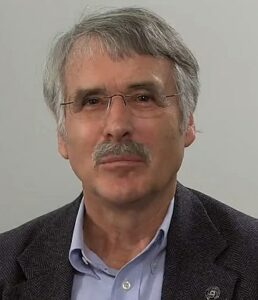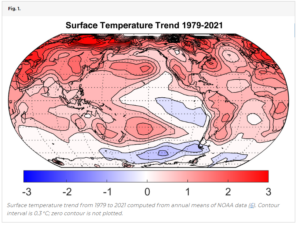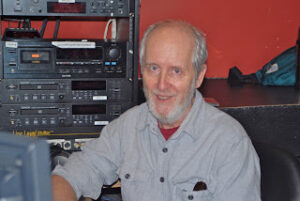Welcome back to a new season of Radio Ecoshock. Alex covers two months of weather madness in 10 minutes. Then top scientists Kevin Trenberth and Dennis Hartmann explain La Nina, the ozone hole, and probable futures.
Listen to or download this Radio Ecoshock show in CD Quality (57 MB) or Lo-Fi (14 MB)
TWO MONTHS OF WEATHER MADNESS IN TEN MINUTES
Billions of people just went through extremes of heat, drought, and floods. This is new: heatwaves covering almost all of the Northern Hemisphere, a global heat event. We lack language and images to comprehend this blast from the hotter future.
PAKISTAN DROWNS IN EXTREME RAINS
As we go on the air, about one third of Pakistan is underwater. Floods have killed over a thousand people and displaced millions, wiping out homes and possessions of already poor people. The floods followed relentless roasting heat starting early and staying long. Damage assessments are still coming in (communications are poor) but so far estimates are:
1350 people killed
50M people displaced
900K livestock deaths
1M houses washed away
40+ reservoirs breached
220+ bridges collapsed
90% cropped damage
$10B loss to economy
Tweeter @QasimRashid says: “If Pakistan were a Western nation we’d see 24/7 coverage”.
The Pakistani government is clear: this battering by the elements is caused by climate change – and the people of Pakistan are not to blame for that. Industrialized countries built on free discharge of carbon into the atmosphere caused this, and should pay restoration costs. Pakistan’s Minister for Climate is calling for help from industrialized countries who polluted the atmosphere. Of course, the guilty parties will not pay, despite years of pledging billions for a climate fund. A few charities and aid aside, the poorest victims of climate change are being left on their own.
For more, consult this article in Nature: “Why are Pakistan’s floods so extreme this year?” And this BBC article on Pakistan floods and climate change.
CHINA’S SUMMER FROM HELL
The other untold headline story is the new Summer in China. Across this large country, heat arrived early, broke record after record, and stayed not days, weeks, but months – in fact 70 days of heat! The major producing region of Sichuan had to shut down factories for name brand companies like Apple and Intel because of heat and lack of electricity. Rivers and lakes ran so low they exposed relics from the Middle Ages, and of course hydro power was slashed. Crops and the landscape were baked dry. Wildlife disappeared, some burned out of their habitats.
The heat wave lasted over 8 weeks. Not only were daytime high records broken day after day, but night time minimum temperatures stayed above 30 degrees C, 86 Fahrenheit. People could not cool down at night, and that is very dangerous for health and fatalities. Korea suffered through long-lasting heat waves too.
Heat in China went over 40 degrees in many provinces, hitting 44.6 C or 112 Fahrenheit in Zhushan, Hubei Province. Some temperatures are underestimates because the Chinese government has a habit of capping weather reports at 40 degrees C. – even when car and home thermometers posted on the Net went closer to 50 degrees C, over 120 F.
The Government of China is among the most aware of climate change risk. Every year, China installs more alternative energy like solar than the rest of the world. The government provides more funding for Chinese climate science than most others, including the United States. But now the Chinese people know rapid action is needed. Nobody wants to live through that heat every summer. We still do not know how much of China’s crops survived.
In Japan, over 1000 all-time heat records were broken in the Summer of 2022. Tokyo sweltered for weeks. Productivity was down. Japanese of all ages suffered, and like people everywhere, we begin to fear the future in a destabilized climate. I have an interview in a coming show about the damage to well-being as climate change ramps up.
EUROPE SWEATS IT OUT
Most of the super heat news from the Far East was barely reported in Western media. Europe and North America had their own heat headlines. No doubt you heard about unbearable weeks of heat in Spain, along with fires torching whole landscapes. That spread into France, setting more records. Rivers in France and Germany went as low as China, again revealing rocks and ships not seen for hundreds of years. Electricity generation in France plummeted with low rivers, and essential German barges had difficulty finding enough water to navigate the Rhine River.
When rivers die, or dwindle to puddles and narrow creeks, all kinds of wild things die. River regions are ecological hot-spots. We barely know the fisheries, insects, birds and mammals that died off in the long 2022 heat waves and drought..
NORTH AMERICA
When this program began in 2006, heat covering a whole continent was remarkable. A few years later I reported on the first transcontinental heat, stretching from North America over Northern Europe. But this is the very first summer I have seen global heat, an entire hemisphere sweltering through long-lasting record heat. You probably know about horrible heat in the Southern U.S. States, wafting up from time to time into the Eastern Seabord. The U.S. Southwest went through it’s 14th year of drought, with more massive wildfires especially in California. Even in the first week of September, 11 states in the West went over 100 degrees or 37 C.
From the New York Times: record-smashing heat in California – in September!
Michael Powell and Shawn Hubler report:
“A vast dome of high pressure has edged westward and settled over California, inflicting sweltering and record-setting temperatures across much of the state and threatening to strain the state’s power grid.
Record high daily temperatures scorched several cities across the Bay Area on Monday, with oppressive heat forecast to continue for days, according to the National Weather Service. Gilroy hit 112 degrees, breaking a daily record of 106 that was set just two years ago. Temperatures in Livermore hit 116, topping a daily record of 108 degrees from 1950.
In Southern California, Pasadena touched 103 degrees over the weekend, breaking a daily record set in 1938. Burbank hit 110 degrees. In the Central Valley, a federal meteorologist forecast that Fresno, a city of more than 500,000, would top out at 114 degrees on Tuesday — three degrees higher than the city’s all-time high temperature for September.
“It’s definitely record-setting,” said Bill South, lead meteorologist for the National Weather Service in Hanford, Calif., where the temperature is forecast to hit 110. “We get heat waves in September but rarely as intense as this one.”
NORTH AFRICA AND THE MIDDLE EAST
Again, weather reporting from North Africa and the Middle East seldom filters through Western media and minds. Heat maps of North Africa this summer made me cringe, going over 50 degrees C, 122 F. regularly, on and on. Is it any wonder that countless millions of people in North and East Africa are out of food, starving? Their emissions did not bring this new climate. We did. North Africa is becoming uninhabitable for months every year. In Taroudant Morocco, 4 a.m the temperature was still 40.4 degrees C, 104 degrees F. for the coolest time of the night, with hot winds blowing. Expect mass migration from North Africa to continue.
Oh Iraq and Iran! Few of my listeners could live through those extreme temperatures in the Middle East this year, especially without air conditioning, as hundreds of millions did. In early August, the highest temperature in the world was in Abadan Iran: 53.0 degrees C, 127 degrees Fahrenheit in the shade! In Iraq, Basra held the world’s hottest 2022 day with 52.6 C. That is a city of 1.3 million people, most without air-conditioning, and electricity is not reliable, even for fans. In the Gulf state of Qatar, the hottest August day ever recorded was on the 8th, with 49 degrees C, 120 F.
THE GLOBAL HEAT WAVE – BROKEN BY FLOODS
2022 is a summer to remember: the first all-out record-breaking global heat wave struck the Northern Hemisphere. Then it broke down into flash floods in many countries. The heaviest rain ever measured in Korea’s capital of Seoul struck August 8. It was crazy with homes, roads, everything under feet of water in a couple of hours. Similar flash floods washed out cities in China and the United States, from Kentucky to Nevada. Hotter air carries more moisture, so when it comes down, the deluge. King Heat says: “Apres moi, le deluge”.
A lot of this extreme weather is the raw result of too many greenhouse gases in the atmosphere. But the expression of destabilization is channeled by long standing natural variations in the atmosphere, especially in the world’s oceans. In this program, Dr. Kevin Trenberth will explain the impacts of La Nina currently at play. Trenberth published his first paper on El Nino/La Nina in the 1970’s and remains the authority. Then another world leading scientist, Dr. Dennis Hartmann leads us into why the La Nina pattern is coming more often. Improbably, the trail leads back to Antarctica, and the ozone hole. We are about to explore the workings of a strange planet, third from a sun in space.
=================
KEVIN TRENBERTH ON LA NINA/EL NINO
HOW THE PACIFIC DRIVES WORLD WEATHER
What is behind the weird extreme weather of 2022? Let’s dive into the big system in the Pacific Ocean that drives so much weather in the Americas, Europe, and beyond. TV weather casters point to La Nina, or to El Nino. But scientists call it ENSO. That includes another pattern change called “the Southern Oscillation”.
Here to explain is one of the world’s top climate scientists, Dr. Kevin Trenberth. He is a Distinguished Scholar at NCAR, the U.S. National Center for Atmospheric Research and IPCC report leader. We will be working from Trenberth’s new book “The Changing Flow of Energy Through the Climate System”. This is the first of a three part in-depth interview with Dr. Trenberth, exclusively for Radio Ecoshock.

Greenhouse gases bounce more solar energy back to the surface – energy that would previously have escaped into space, helping Earth maintain a stable climate. The resulting warming does not happen on a blank canvas. Nature’s regular pattern changes continue. For example, there is a weather pattern over the North Atlantic Ocean that goes back and forth. It is called the North Atlantic Oscillation (NAO), and can determine whether the U.S. Northeast, UK, and Northern Europe are on a storm track, or whether that heavy weather goes further north to Scandinavia. Kevin explains the NAO a bit in our interview, and in depth in his new book.
But scientists find the North Atlantic changes determine less of world weather than the much larger patterns coming out of the vast Pacific Ocean. A combination of ocean and wind patterns can bring up cold water off South America, and pile up hot water in the Western Pacific, around Indonesia for example. That is La Nina, which generally lasts a year or two. In 2022, we experienced a third year of La Nina, which is somewhat rare. Our second guest Dennis Hartmann suggests reasons why Earth may experience more La Nina states in coming decades, maybe for the next 60 years.
Eventually, as Kevin puts it, the Western Pacific can’t take any more hot water, and the whole system reverses. That is El Nino, and the hottest years on record, at least since the year 2000, have all been El Nino years. That means the Pacific La Nina condition has been “masking” (hiding) the true amount of heat we should expect from our greenhouse gases.
In a previous interview on Radio Ecoshock, Dr. Trenberth told us that human-induced warming has overpowered the El Nino/La Nina system (called “ENSO”). That is why we got a phenomenally hot summer in the Northern Hemisphere this year – even though the Pacific was cooling the planet a little. Heaven help us when a strong El Nino piles up heat on top of the warming humans are adding all the time! We know El Nino leads to more extreme events, compared to it’s milder counterpart La Nina.
In the Trenberth interview, we also discuss how ENSO and climate change team up to increase salty ocean deserts in the ocean. Nobody is talking about this. Ocean desertification an issue worth watching.
After this interview, you should understand more about the second biggest driver of global weather, after global warming.
Listen to or download this new 22 minute interview with Dr. Kevin Trenberth in CD Quality or Lo-Fi
BARRIERS TO UNDERSTANDING ENSO – thoughts from Alex Smith
There are fundamental barriers for an easy public understanding of the ENSO phenomenon. They include:
* all of our thinking is based on land. For example we consider the Pacific according to the geography of the Americas, Asia and Pacific Islands on our mental maps. We really do not have a map of the Pacific, or operate from that viewpoint.
* geography viewed from the ocean uses language directly opposite to historic labels developed by Western land humans. That English calls China the Far East. But once you cross the West coast of the Americas, you are no longer in the West, but in the Eastern Pacific. The Western Pacific is over near China, and Indonesia. Reading scientific explanations for WHERE hot pools, winds or currents exist is requires translation into the opposite of common thinking. The Eastern Pacific is not near Asia, but Peru.
* ENSO is generally explained as the changes between the El Nino state and La Nina. It is not that. “ENSO” stands for El Nino and the Southern Oscillation. The Southern Oscillation never occurs near the original centers of western thought, in the Northern Hemisphere or the Atlantic. The majority of humans probably do not know what the “SO” part of ENSO stands for. Note the Southern Oscillation theory is credited to early meteorologists Gilbert Walker and Jacob Bjerknes. So one half of ENSO is left out of most public dialog.
Kevin Trenberth adds more three complexities.
One: there is no neutral state in the El Nino/La Nina cycle. The direction of ocean heat transfer in the Western Pacific is in one state or the other. We might have very weak La Nina years, but the ocean there is always one way or the other.
Two: Although weather forecasters have taught the public something about expected impacts from El Nino, the name should really be plural: El Ninos. Scientists have found several different expressions. For example, the expected hot water off Peru might not happen. It might pool in the middle of the Pacific, where no one sees. In private correspondence (July 2022), Trenberth suggested the next El Nino – layered over human-induced warming – may well be a new type, something not seen before. In Chapter 2 of Kevin’s book he says: “All of the impacts of El Nino are exacerbated by global warming.”
Three: El Nino brings more extremes than La Nina, which tends to be milder. Expect great weather changes during El Nino years, unless you live in Australia. La Nina affects Australia – with heavy rains and floods, as in 2022 – more than North America.
* we are dealing with things humans cannot see: ocean currents and flows of air, sometimes deep underwater or high in the sky. These are activities or motions more than “things”, leaving us little to grasp.
* the whole ENSO concept is the pinnacle to a mountain of complexity – some of which has taken decades of specialists to guess at, and computerized models to comprehend and prove. It might take a generation of dedicated courses, beginning in early school years, for large numbers of humans to understand these complexities of how nature actually operates, and what makes extreme weather events possible.
* Then, when ENSO is finally understood, to whatever depth, we arrive at questions about relationships between ENSO and climate change! What drives what ? How can we separate the two, or should we? Does global warming build into continuing El Nino patterns Could a very strong El Nino year tip us precipitously into a lasting hotter state prepared by human-induced warming?
=============================================
DENNIS HARTMANN: COULD THE OZONE HOLE BE HIDING REAL WARMING?
Strange droughts, flash floods, weird weather, welcome to La Nina in the age of climate change. Why are La Nina years coming more often? Dr. Dennis Hartmann has a surprising answer: it could be the ozone hole. Worse, this trend might hide real warming to come. Published in the Proceedings of the National Academy August 22nd, 2022, Hartmann’s new paper is: “The Antarctic ozone hole and the pattern effect on climate sensitivity”. The paper is available free, in full text here.
At the University of Washington, Dennis L. Hartmann is professor in the Department of Atmospheric Sciences and Senior Fellow of the Joint Institute for the Study of the Atmosphere and Ocean. With about 200 articles published and a long list of top awards, Hartmann was a Coordinating Lead Author for the Fifth Assessment of the Intergovernmental Panel on Climate Change. He is author of the college textbook “Global Physical Climatology”, now in the Second Edition.

Dr. Dennis L. Hartmann, University of Washington
Listen to or download this 26 minute interview with Dr. Dennis Hartmann in CD Quality or Lo-Fi
There is a startling map in Hartmann’s paper that was new to me, and probably our listeners as well. Figure 1 shows a world getting hotter on land and sea as you might expect- except for two huge ocean zones where sea surface temperatures are actually getting cooler. The strange cooling in the Eastern Pacific does not appear in climate models, which show a warming should be there. It stands out as weird in a heating world.

THE OZONE HOLE HAS NOT HEALED! THAT IS A MYTH.
Those strange cooling zones in the ocean, while the rest of the world (land and sea) heats up, cries out for explanation. That is what we investigate in this interview, but along the way we blow up a continuing media myth. Almost every day I see informed, educated people on television pointing to the Montreal Protocol of 1987 as an example of human acting successfully to overcome a global problem in the atmosphere. Then they stumble by saying the ozone hole was healed. No it isn’t.
Chlorofluorocarbons were used around the world as refrigerants – partly because they are “inert”. That stable molecular form of chlorine mixed with carbon is not explosive, and does not break down easily. Scientist James Lovelock testified to Congress that CFCs were perfectly safe for the atmosphere, one of his major blunders. Then scientists realized CFC’s were blocking the production of ozone, the form of oxygen that protects us from very harmful rays from the sun, the ultraviolet rays.
Yes, under the Montreal Protocol most (but not all!) production of CFCs’ and related gases has stopped. But the ozone hole continues, mainly over Antarctica. Dennis Hartmann explains the tediously slow process of how CFCs break down in the stratosphere, meaning there will be an ozone hole, likely for the next 60 to 70 years.
Maybe the ozone hole will not shrink even then. A new paper published by Rachel Pannett is titled “Australian wildfires cause the largest stratospheric warming since Pinatubo and extends the lifetime of the Antarctic ozone hole”. As the world warms, a lot more forests will burn, possibly damaging stratospheric ozone. Could that extend the time of La Nina dominance as well? But it is possible the Australian fires extended the length of time the ozone hole appeared that year, rather than extending it’s life into future years.
IN THE FUTURE: MORE EL NINO OR MORE LA NINA?
Work from Dennis Hartmann and others suggest climate change will tilt the world toward more La Nina years. For a while, scientists predicted more El Nino events due to global warming. For example, a paper led by Bin Wang in PNAS October 21, 2019 predicted “more frequent extreme El Niño events”. But on close reading, this paper really talks more about more extreme El Ninos when they do come, rather than more El Nino events. The jury is still out.
HOW OZONE AFFECTS CLIMATE
The continuing existence of the ozone hole affects temperatures in the atmosphere, and thus winds around Antarctica. Those cooling winds can affect the Pacific right up to the coast off Peru. As a result, more low clouds form over the Eastern Pacific, leading to more cooling of sea surface temperatures. This could explain the strange cold pools shown in Figure 1 above.
The Hartmann paper in PNAS says:
“In this mechanism, a surface wind shift in high latitudes associated with the Antarctic ozone hole triggers a cooling of the Southern Ocean] which, through feedback processes involving atmospheric circulation, low-cloud feedbacks, and ocean current changes, leads to a cooling in the eastern tropical Pacific Ocean.”
At first, I found connecting the ozone hole to Pacific cooling thousands of miles away unlikely. But then I found a series of papers, mainly led by Chinese scientists, finding connections between a thin ozone layer over Antarctica, and the cycle of El Nino/La Nina known as ENSO. The ozone hole impacts climate systems.
Hartmann says this is an example of a “teleconnection” – where conditions in one part of the world change a system a great distance away. You might think that the ozone to cloud formation would be a negative feedback effect (a process that cools rather than heating Earth). Hartmann thinks we have to be careful about terminology there. But it seems to me, this unexpected ozone/Antarctic connection may be yet another factor masking the true heating we force on the earth with greenhouse gas emissions. What happens to warming by year 2070, when the ozone hole might really be healed? Will it be worse because this cooling mechanism is gone?
It is all detective work. We know the facts. It will likely take more science to really determine why a big region of the Pacific is cooling while the world warms.
=================
FREE WEBINAR COMING UP
In a coming show, we will talk with Carolyn Baker. She is a former psychotherapist and professor of psychology and history. Her latest book is “Undaunted: Living Fiercely into Climate Meltdown in an Authoritarian World.”
Carolyn is putting out two free webinars you may want to attend. The title is “What Is This Global Crisis Asking Of Us?” The webinars are scheduled for two consecutive Thursdays later this September, on the 15th and on the 22nd. Both start at 2:00 pm US Eastern Daylight Time. Carolyn’s co-host is Dr. Eric Garza, Lecturer at the Rubenstein School for Environment and Natural Resources. Garza has a number of courses on local food production and what we can do in the face of climate-driven collapse. The two webinars are absolutely free. Find out more at carolynbaker.net.
I have lots of great science coming up for you, to help understand extreme weather around the world – and what we all must do to survive, now that everyone knows climate change is real. A big thank you to everyone who has supported this radio show over the years, especially the volunteers who spread climate truth far and wide, never giving up. Send your ideas and tips to me anytime. The show email address is: radio@ecoshock.org.
As we return this week, we welcome new listeners in Houston Texas and beyond, via KPFT FM HD-2 channel, Saturdays at 3 pm Central time.
I’m Alex Smith, thank you for listening – and caring about our world.
